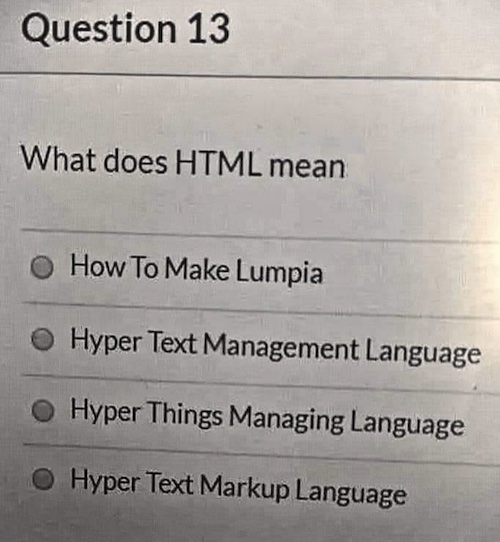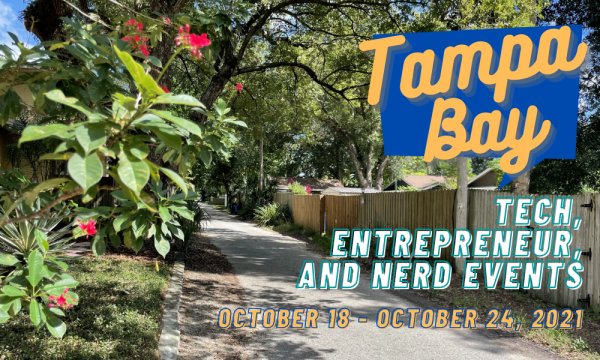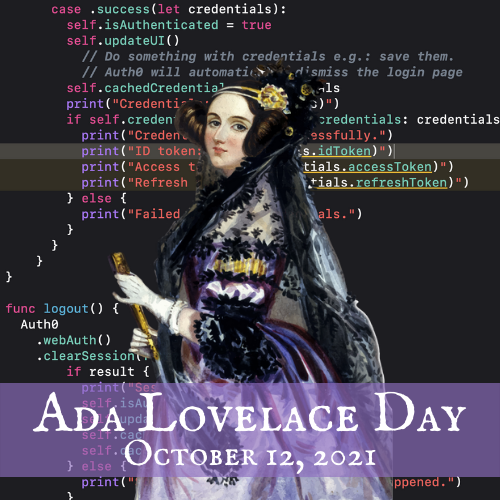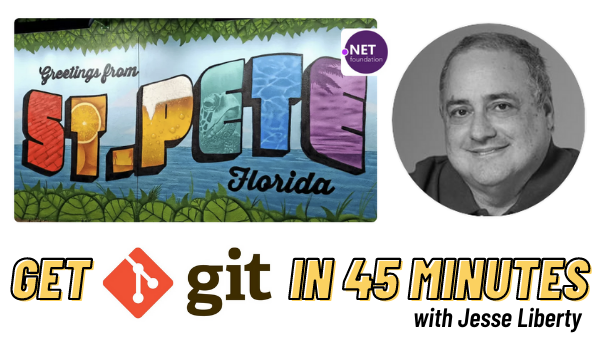
In case you were wondering, lumpia are Filipino spring rolls.

In case you were wondering, lumpia are Filipino spring rolls.
Here’s your weekly list of tech, entrepreneur, and nerd events — plus a little area tech news — for Tampa Bay and surrounding areas for the week of Monday, October 25 through Sunday, October 31, 2021.
This is a weekly service from Tampa Bay’s tech blog, Global Nerdy! For the past four years, I’ve been compiling a list of tech, entrepreneur, and nerd events happening in Tampa Bay and surrounding areas. There’s a lot going on in our scene here in “The Other Bay Area, on the Other West Coast”!
As far as event types go, this list casts a rather wide net. It includes events that would be of interest to techies, nerds, and entrepreneurs. It includes (but isn’t limited to) events that fall under the category of:
By “Tampa Bay and surrounding areas”, this list covers events that originate or are aimed at the area within 100 miles of the Port of Tampa. At the very least, that includes the cities of Tampa, St. Petersburg, and Clearwater, but as far north as Ocala, as far south as Fort Myers, and includes Orlando and its surrounding cities.
This list includes in-person events as well as online events. The COVID-19 numbers are dropping sharply, but be smart and responsible — get your shots, mask up in crowds, and we can get back to what passes for normal sooner!
| Thinkful Tampa | Thinkful Webinar || Bootcamp Alumni Success Secrets | 9:00 AM to 10:30 AM EDT |
| Tampa Bay Geek Association | Lumi-Con | 10:00 AM |
| Shut Up & Write!® St. Petersburg | Shut Up & Write! – October 31st at the Station House in St Pete | 10:00 AM |
| Tampa Bay Classic Film Club Meetup Group | Nosferatu – the first vampire movie (silent) | 2:00 PM |
| Thinkful Tampa | Thinkful Webinar || What Tech Career Is Right For You? | 6:00 PM to 7:30 PM EDT |
Let me know at joey@joeydevilla.com!
If you’d like to get this list in your email inbox every week, enter your email address below. You’ll only be emailed once a week, and the email will contain this list, plus links to any interesting news, upcoming events, and tech articles. Join the Tampa Bay Tech Events list and always be informed of what’s coming up in Tampa Bay!

Here’s your weekly list of tech, entrepreneur, and nerd events — plus a little area tech news — for Tampa Bay and surrounding areas for the week of Monday, October 18 through Sunday, October 24, 2021.
This is a weekly service from Tampa Bay’s tech blog, Global Nerdy! For the past four years, I’ve been compiling a list of tech, entrepreneur, and nerd events happening in Tampa Bay and surrounding areas. There’s a lot going on in our scene here in “The Other Bay Area, on the Other West Coast”!
As far as event types go, this list casts a rather wide net. It includes events that would be of interest to techies, nerds, and entrepreneurs. It includes (but isn’t limited to) events that fall under the category of:
By “Tampa Bay and surrounding areas”, this list covers events that originate or are aimed at the area within 100 miles of the Port of Tampa. At the very least, that includes the cities of Tampa, St. Petersburg, and Clearwater, but as far north as Ocala, as far south as Fort Myers, and includes Orlando and its surrounding cities.
This list includes in-person events as well as online events. The COVID-19 numbers are dropping sharply, but be smart and responsible — get your shots, mask up in crowds, and we can get back to what passes for normal sooner!
Let me know at joey@joeydevilla.com!
If you’d like to get this list in your email inbox every week, enter your email address below. You’ll only be emailed once a week, and the email will contain this list, plus links to any interesting news, upcoming events, and tech articles. Join the Tampa Bay Tech Events list and always be informed of what’s coming up in Tampa Bay!
Here are the developer meetups in Tampa Bay and surrounding areas that I think you might find interesting and useful. All of them are online!
From their Meetup page:
Ever wanted to give a tech talk? Did you build something cool and want to share it? Want to workshop a presentation? Then this event is perfect for you!
A lightning talk is a short presentation. For this event, we are looking for about 6 people to give 10 minute talks with about 5 minutes for questions at the end of the presentation. We are looking for both technical and non technical talks related to programming, career support, education, or other relevant topics. Preference will be given to those giving their first presentation, but we will accept any level.
Tonight’s topics:
For more details about this event, see its Meetup page.
Hey, Tampa Bay developers — come meet your local peers at Suncoast Developers Guild’s Open Code! It’s where local people who work with code can get together, bounce ideas off each other, ask questions or look for help, and get to know each other. This is the kind of get-together that makes a city a tech hub.
From their Meetup page:
We don’t have any particular format, and we won’t be doing any presentations. But we do a brief round of introductions at about 7:15 just to help break the ice and get to know each other a bit.
For more details about this event, see its Meetup page.
From their page:
Each week we will learn a bit more in our journey to become Android developers.
We begin by building different Android apps with the Kotlin programming language. This includes creating multiple layouts and adding user interactivity to our Android apps. We define navigation paths and start an external activity. You will learn how handle complex lifecycle situations and add logging.
We continue our journey by learning about architecture components, such as ViewModel and LiveData. We create a database using the Room library. And display a list of clickable items with RecyclerView. We will load and display data from the internet. Making our app more accessible for all users.
In the final weeks we learn the more advanced techniques of building Android apps using libraries, testing, Jetpack and more to increase the quality of your app
For more details about this event, see this page.
From their Meetup page:
In this talk, presented by AJ, we will learn how Elixir lays out structures in memory, and how it behaves when we transform data immutably. Then, we’ll use this knowledge to guide how we choose data structures for a real world app.

I nearly forgot that the second Tuesday in October is Ada Lovelace Day! I wanted to get this message out before the day had come and gone.
She’s best known for producing what’s considered to be the definitive documentation for Charles Babbage’s Analytical Engine, which was then only a proposed design that could not have been built with the tools of that era. She also realized that the Engine, primitive as it was, could have applications beyond just number-crunching. For the work she did, she’s considered to be the first computer programmer, and I also consider her the first to do my current job of developer advocate.
Today, Ada Lovelace Day commemorates and celebrates the work of women in STEM — that is, science, engineering, technology, and math. Ada Lovelace Day will probably be over by the time you read this, but nothing’s stopping you from some belated celebration!

Want to make sure that you really understand Git and all its workings? Want to learn from someone who really knows their stuff? Then join tonight’s St. Pete .NET Meetup virtual session with Jesse Liberty, who’ll start with the basics, but ramp up to cover advanced topics such as rebasing, interactive rebasing, and bisect (which is for finding the commit that broke your code).
When I needed to brush up on my C++ during the dot-com boom, I had Stroustrup’s book, but it was this Jesse Liberty C++ book that was my true guide…
…and when I got a developer relations job at Microsoft in late 2008 and had to relearn C# in a hurry, I turned to this Jesse Liberty book:
So along with his Microsoft and Xamarin MVP credentials, and his courses for Pluralsight, LinkedIn Learning, and Packt, there’s also my endorsement (for what it’s worth) that he can teach tricky tech topics in a way that makes it “stick”.
StartupBus — the annual hackathon where techies, idea people, marketers, and creatives board a bus bound for New Orleans and build an application and the business around it while on the bus — is giving back to the city that has given so much to it. They’re holding an event called #StartupBusForNOLA this Friday, October 15th at Green Bench Brewing Co. in St. Pete!
Their goal is to raise $5,000 for NOLAvate Black, an organization whose goal is to build a more sustainable, accessible, and diverse technology ecosystem in the Greater New Orleans region. NOLAvate Black was founded by Sabrina Short, who served as a judge in the last StartupBus finals in 2019 (where my team and I were one of the finalists).
New Orleans has been through a lot of challenges, including Hurricane Ida, which blew through in late August. They could use our help, as StartupBus founder Elias Bizannes explains:
And that’s why we’re holding #StartupBusForNOLA this Friday at Green Bench!
